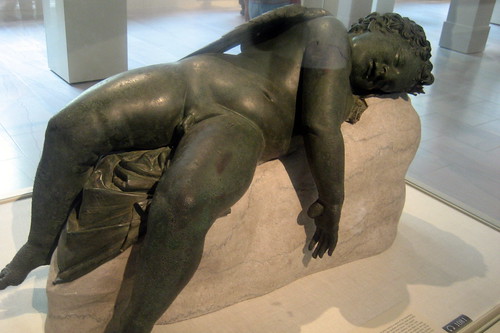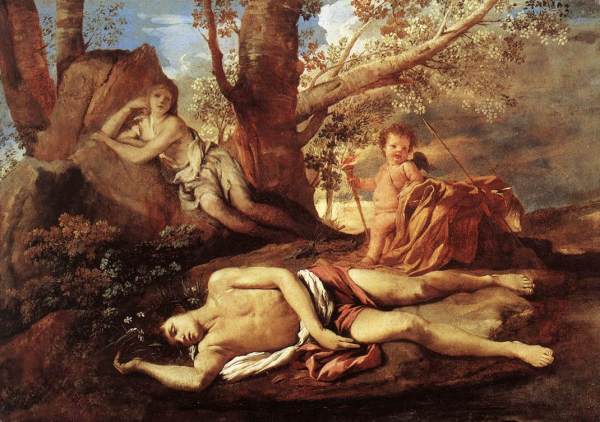Peter Aprahamian, Freud's Desk in London
Can you spot the Narcissus blossoms?
It troubled the beloved and detested Father of Psychoanalysis (and Butt of Jokes) Sigmund Freud that he witnessed his friends, family, and patients compelled to repeat thoughts or actions that gave them no pleasure, fulfilled no evident need, and sometimes gave them great pain. His earlier conception of the seesaw action of the pleasure principle-- whereby people seeks pleasure and avoid pain-- counterposed by the reality principle-- whereby people get their jobs done and floss their teeth-- did not explain why people would repeat, relive, or re-enact distressing or traumatic acts and events, often compulsively. Freud worked through the causes of these destructive behaviors (repeatedly) in his 1920 essay Beyond the Pleasure Principle, determining finally that the pleasure principle and reality principle did not in fact oppose but rather balanced each other, and he came to see them combined under a life drive or Eros, and conceptualized a separate drive that initiated destruction of others and self-destruction an avenue to return to an inanimate state that we might remember on a cellular level from before our physical conception. He referred to this drive as the death drive; after Freud many have labled it Thanatos, for the Greek personification of death.
Eros and Thanatos as conceived by the Greeks:

Eros Sleeping, Hellenistic Greek, 3rd century BC–early 1st century AD, marble and bronze, ~34" long
now at the Metropolitan in NYC
now at the Metropolitan in NYC

Thanatos on the right with his twin brother Hypnos/Sleep
Eros and Thanatos don't meet in battle in Greek myth, but they repeat, relive, and re-enact fights to the death in stories of love gone awry beginning at least with the Greeks, thousands of years before Freud put pen to paper to explore their battle within each of us in. Some examples: Orpheus and Eurydice, Echo and Narcissus, Pyramus and Thisbe, and of course Romeo and Juliet. The story of Narcissus has long captivated me; I remember him again each spring as the fragrance of his flower-namesake drifts across spring lawns and woodlands. Narcissus lost his life to love of self, gave his name to the many-faced flower that heralds spring, then gave his name again to name the psychosis distinguished by excessive self love: Narcissism. He gave his storied image, too, to many artists as inspiration.
The sweet looking and sweet smelling narcissus in bloom.

Pompeiian wall painting Narcissus
Narcissus, so renowned for his beauty, spurned the love of any who wanted him, including the Nymph Echo (whom Hera had punished for her ceaseless talking by cursing her only to repeat what other's said). Told on his birth that he would only live a long life if he did not come to know himself, his parents kept him from catching sight of his image. Inevitably, he saw himself in a pool of water and fell hopelessly, desperately, in love. Starved by the impossibility of having himself, Narcissus wasted away. Echo, still in love, took sympathy and metamorphosed his dying body into a flower.

Caravaggio, Narcissus, 1598, Baroque
Michelangelo Merisi da Caravaggio liked the story enough to paint it. His Narcissus glows with the light of his own beauty. As close to touching his reflection as he could come without destroying it, Caravaggio's narcissus embraces himself, framing the pool of darkness with a pale circle of arms. Yet those arms frame nothing but a pair of knees, moony almost-faces, frame the nothing that is this exclusive love of self.

Nicolas Poussin, Echo and Narcissus, 1660, Neoclassical
Of all the images of Narcissus I've seen, Poussin's does the least for me. The baby Eros/Cupid's arrow has the only vital direction; Echo has given up hope and Narcissus' body angles lifelessly across the shore, his hair transforming into flower roots and animating a wreath of flowers.

John Waterhouse, Echo and Narcissus, 1903, Pre-Raphaelite
Unlike their predecessors, the Realists, Impressionists, Symbolists and Expressionists, the Pre-Raphaelites had no fear of beautiful surfaces. Narcissus proved an irresistible image for John Waterhouse, whose red-draped, laurel-wreathed, writhing boy presses his nearly nude form into the hard rock with some ferocity, as if hoping to press through it into and onto himself. In Waterhouse foretells the end before it comes; the narcissus has sprung up already before the boy's eyes have closed.

Salvador Dali, Narcissus, 1937, surrealist
The story of Narcissus offered rich material to the paintbrush of the surrealist Salvador Dali: the impossibility of reflections, metamorphosis, birth, rebirth, exquisite closeness divided by a gulf of impossibility (If Narcissus touches his reflection in the water, it will fracture, ripple and echo away from him, so he can only gaze, but not have.) Dali borrow's the form of Caravaggio's Narcissus, but none of his boyish beauty, and Dali double's the boy's form into a stony, ancient, unbeautiful hand that holds the egg/seed from which his next form, the many-faced spring narcissus flower, will spring.

Salvador Dali, portrait with narcissus blossoms on his carefully manicured moustache.
What does Dali see when he looks in the pool, in the mirror? His carefully constructed image of himself as artist, his perennially performed life, must point out a powerful form of narcissism?
In His 1985 poem "Narcissus and Echo," Fred Chappell captures the nymph's longing for the impossible to touch Narcissus in his remarkably light-handed echo at each line's end; the poem splits and repeats into two-- an image and a fragile reflection: "Ember of airy longing/ ache of unbeing." Chappell leaves a flicker of hope that the reflection might actually have a being separate from the solid form.
Narcissus and Echo
Shall the water not remember Ember
my hand’s slow gesture, tracing above of
its mirror my half-imaginary airy
portrait? My only belonging longing;
is my beauty, which I take ache
away and then return, as love of
teasing playfully the one being unbeing.
whose gratitude I treasure Is your
moves me. I live apart heart
from myself, yet cannot not
live apart. In the water’s tone, stone?
that brilliant silence, a flower Hour,
whispers my name with such slight light:
moment, it seems filament of air, fare
the world becomes cloudswell. well
Felix Gonzalez-Torres, Untitled (Perfect Lovers), 1995

Jenny Tattersall and Jarek Cemerek in Cathy Marston's Echo and Narcissus, 2001
Here the lovers defy the classic tale, finally, and defy Thanatos, at least for one dance. Narcissus and Echo meet to blossom together and against each other, doubled in the extraordinary reflective black pool of a stage they dance on.



No comments:
Post a Comment